|
|

|
|
Author
|
Topic: SpaceX Falcon 1 rocket and launches
|
Robert Pearlman
Editor Posts: 42988
From: Houston, TX
Registered: Nov 1999
|
 posted 08-02-2008 06:54 PM
posted 08-02-2008 06:54 PM
   
The current hold is to determine collision avoidance with the International Space Station. Liftoff is now expected at 5:55 p.m. PDT / 8:55 p.m. EDT / 00:55 UTC. |
Robert Pearlman
Editor Posts: 42988
From: Houston, TX
Registered: Nov 1999
|
 posted 08-02-2008 07:01 PM
posted 08-02-2008 07:01 PM
   
T-55 minutes and counting. 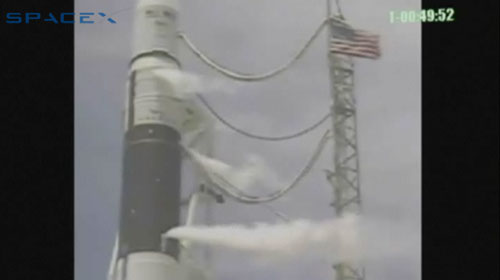 |
Robert Pearlman
Editor Posts: 42988
From: Houston, TX
Registered: Nov 1999
|
 posted 08-02-2008 07:48 PM
posted 08-02-2008 07:48 PM
   
The countdown has entered an unplanned hold at T-16 minutes due to the extended time needed to cryo-chill the helium.Update: Fuel offloading has begun and topping off helium has been aborted... Update 2: There has been mention on the flight controller loop of refueling the vehicle but no timeline has been given as detanking is still underway. Tonight's launch window remains open until 11:00 p.m. CDT. Update 3: Per SpaceX, they are working a "minor issue" but are confident they will launch during this launch window. The webcast will resume in about 30 minutes. Update 4: The de-fueling was to ensure that the helium (using to pressurize the vehicle) would not cool the refined kerosene fuel. |
Robert Pearlman
Editor Posts: 42988
From: Houston, TX
Registered: Nov 1999
|
 posted 08-02-2008 08:37 PM
posted 08-02-2008 08:37 PM
   
Before resuming the count, controllers need to finish loading the last of the helium and then refuel the vehicle, which is expected to occur within time to launch during tonight's window.When Falcon 1 lifts off, flying with its payload will be the remains of 208 people from 14 nations, including Mercury and Gemini astronaut Gordon Cooper. |
Robert Pearlman
Editor Posts: 42988
From: Houston, TX
Registered: Nov 1999
|
 posted 08-02-2008 09:10 PM
posted 08-02-2008 09:10 PM
   
T-50 minutes and counting... which would put the new liftoff time at 8:00 p.m. PDT / 11:00 p.m. EDT / 03:00 UTC |
Robert Pearlman
Editor Posts: 42988
From: Houston, TX
Registered: Nov 1999
|
 posted 08-02-2008 09:36 PM
posted 08-02-2008 09:36 PM
   
T-25 minutes and counting... no problems are being worked, refueling continues and weather remains good for launch. |
Robert Pearlman
Editor Posts: 42988
From: Houston, TX
Registered: Nov 1999
|
 posted 08-02-2008 09:55 PM
posted 08-02-2008 09:55 PM
   
T-5 minutes and counting. 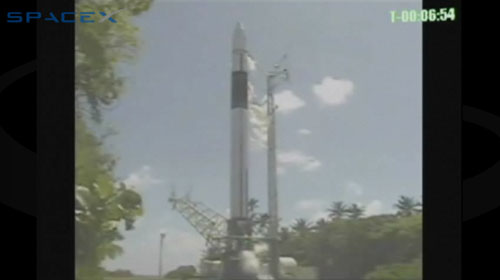 |
Robert Pearlman
Editor Posts: 42988
From: Houston, TX
Registered: Nov 1999
|
 posted 08-02-2008 10:04 PM
posted 08-02-2008 10:04 PM
   
Abort! A T-0.5 seconds, an abort was called as a result of a propulsion parameter being about one-percent out of range.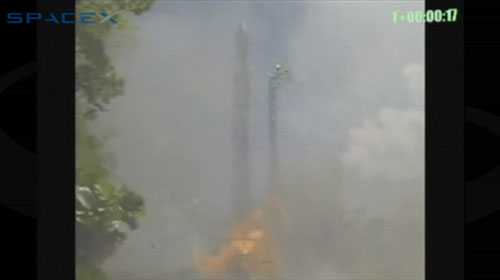 There may still be time however, to reset the count at T-10 minutes and launch before the window closes at 11:00 p.m. CDT. Update via Kwajalein Atoll and Rockets blog: Turbopump purge pressure was 0.5 psi off. Adjustments made. T-10 minutes and counting! |
Robert Pearlman
Editor Posts: 42988
From: Houston, TX
Registered: Nov 1999
|
 posted 08-02-2008 10:41 PM
posted 08-02-2008 10:41 PM
   
At 10:34 p.m. CDT, Falcon 1 lifted off the pad at the Kwajalein Atoll, about 2500 miles southwest of Hawaii. Two minutes and 13 seconds into flight, the video downlink from the vehicle was lost. "We are hearing from the launch control center that there has been an anomaly on that vehicle," said SpaceX spokesman Max Vozoff. 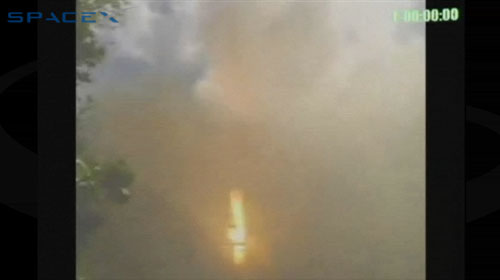 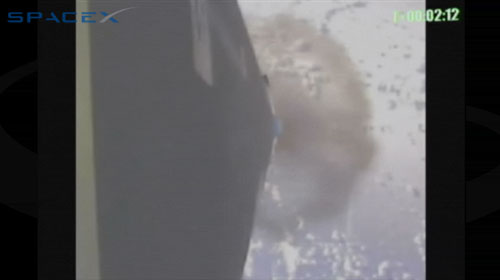
Among the Falcon's payloads were two small NASA satellites, including NanoSail-D, which would have been the first test flight of a solar sail. Also on the rocket were the ashes of the 208 participants in Celestis' The Explorers Flight, a memorial spaceflight, including original Mercury astronaut Gordon Cooper, who died in 2004. The official emblem for tonight's SpaceX flight included a miniature version of the Mercury-Atlas 9 souvenir patch in honor of Cooper. |
hlbjr
Member Posts: 475
From: Delray Beach Florida USA
Registered: Mar 2006
|
 posted 08-02-2008 11:35 PM
posted 08-02-2008 11:35 PM
   
I noticed a gentle oscillation near the end of the televised ascent. I had not seen that oscillation on the previous flights during stage 1. I was thinking to myself how odd that was. I wonder if it is related to whatever has caused the anomaly? |
Robert Pearlman
Editor Posts: 42988
From: Houston, TX
Registered: Nov 1999
|
 posted 08-02-2008 11:41 PM
posted 08-02-2008 11:41 PM
   
Indeed, that oscillation was noted by several members of the space press with whom I was trading instant messages with during the launch. I'm currently on hold for a teleconference with SpaceX CEO Elon Musk. I'm sure the question of the oscillations will be raised...Update: The teleconference was abbreviated as Elon Musk did not participate (he was still in mission control managing the aftermath of tonight's launch failure). In a prepared statement though, Musk attributed the loss to a problem during first and second stage separation. |
Robert Pearlman
Editor Posts: 42988
From: Houston, TX
Registered: Nov 1999
|
 posted 08-03-2008 12:24 AM
posted 08-03-2008 12:24 AM
   
Here is Elon Musk's e-mail to SpaceX employees: Plan Going Forward
It was obviously a big disappointment not to reach orbit on this flight [Falcon 1, Flight 3]. On the plus side, the flight of our first stage, with the new Merlin 1C engine that will be used in Falcon 9, was picture perfect. Unfortunately, a problem occurred with stage separation, causing the stages to be held together. This is under investigation and I will send out a note as soon as we understand exactly what happened.
The most important message I'd like to send right now is that SpaceX will not skip a beat in execution going forward. We have flight four of Falcon 1 almost ready for flight and flight five right behind that. I have also given the go ahead to begin fabrication of flight six. Falcon 9 development will also continue unabated, taking into account the lessons learned with Falcon 1. We have made great progress this past week with the successful nine engine firing.
As a precautionary measure to guard against the possibility of flight 3 not reaching orbit, SpaceX recently accepted a significant investment. Combined with our existing cash reserves, that ensures we will have more than sufficient funding on hand to continue launching Falcon 1 and develop Falcon 9 and Dragon. There should be absolutely zero question that SpaceX will prevail in reaching orbit and demonstrating reliable space transport. For my part, I will never give up and I mean never.
Thanks for your hard work and now on to flight four. |
gliderpilotuk
Member Posts: 3398
From: London, UK
Registered: Feb 2002
|
 posted 08-03-2008 05:53 AM
posted 08-03-2008 05:53 AM
   
"A big disappointment" must be the understatement of the year. No reference to the feelings of the people whose 208 relatives' ashes never made it to orbit on an untested vehicle. |
dsenechal
Member Posts: 539
From:
Registered: Dec 2002
|
 posted 08-03-2008 06:10 AM
posted 08-03-2008 06:10 AM
   
Surely a major disappointment, and my heart goes out to the families whose loved one's remains were lost. Check out the "featured video" of the F1-002-Launch, the featured video on the SpaceX home page. At staging, T+2:51 into the flight (approx 3:27 into the video), it appears that the first stage actually strikes the second stage engine bell as it falls away. I wonder if this happened again in last night's launch, and was related to the failure. Dave. |
Robert Pearlman
Editor Posts: 42988
From: Houston, TX
Registered: Nov 1999
|
 posted 08-03-2008 09:37 AM
posted 08-03-2008 09:37 AM
   
quote:
Originally posted by dsenechal:
I wonder if this happened again in last night's launch, and was related to the failure.
Perhaps but according to Musk, the stages were held together, leading to the loss of vehicle. There's also the issue of the (apparent) timeline; the live video feed ended nearly a half-minute before separation and SpaceX says the cutoff was triggered by the anomaly. |
E2M Lem Man
Member Posts: 846
From: Los Angeles CA. USA
Registered: Jan 2005
|
 posted 08-04-2008 08:20 PM
posted 08-04-2008 08:20 PM
   
Remember how we always joke about "rocket science"? Well, this is a reminder that it is an emerging science. Our United States government spent BILLIONS of tax dollars to learn these secrets, make that science, and still rockets fail and missions fail and equipment is lost. Atlas, Titan, Thor, all had significant failures before successes. But there are still failures after that. Atlas Agena target-6, the angry alligator of Gemini 9, Mariner 3, Mariner 8, and so on to today.These are machines, and like our automobiles there will be failures. But about SpaceX: this is not your government funded rocket booster. This is new rocket design from a new, small company that is primarily funded by an individual, Mr. Elon Musk. His team out of El Segundo, CA, does not have the benefits of a Boeing or a Lockheed Martin. They have only the knowledge of their own testing and launching.. .and from their own failures. If this failure is a crossed wire or a catastrophic one, they deserve the benefit of time to discover what went wrong, how to fix it, and make sure the designs are proven. There cannot be an operational program based on a single or two or three launches. This was learned by NASA on Apollo 6, where after the first almost perfect Saturn 5 flight multiple failures almost doomed the second test. But telemetry told them what went wrong and they were able to man Apollo 8. But on every flight or every test they found problems that had to be fixed. This lesson was repeated on Operational vehicles named "Columbia" and "Challenger" also. Rocket Science is not easy. |
Robert Pearlman
Editor Posts: 42988
From: Houston, TX
Registered: Nov 1999
|
 posted 08-04-2008 08:26 PM
posted 08-04-2008 08:26 PM
   
Wired: Q&A: SpaceX's Elon Musk Vows to Make Orbit Wired.com: What happened up there Saturday?Elon Musk: We're not quite ready to release details on the initial investigation yet, but we should do it very soon. We think we have a very good idea but I don't want to get ahead of ourselves and then be wrong. We definitely know where the problem occurred, but 'why?' is the question. We think we know, but have to be sure. We think it's very small and will require a tiny change, so tiny that if we had another rocket on the pad we could launch tomorrow. |
zee_aladdin
Member Posts: 781
From: California
Registered: Oct 2004
|
 posted 08-05-2008 11:04 PM
posted 08-05-2008 11:04 PM
   
I've worked in aerospace before and our company lost many rockets due to weird and unexpected failures. That is why when we used to design and build them, we were required to put not just one, but TWO, destruct systems just in case the rocket failed, and the first destruct did not work. So in this field it is high risk most of the time.
|
Robert Pearlman
Editor Posts: 42988
From: Houston, TX
Registered: Nov 1999
|
 posted 08-06-2008 10:34 PM
posted 08-06-2008 10:34 PM
   
Elon Musk issued the following statement this evening: Timing is EverythingOn August 2nd, Falcon 1 executed a picture perfect first stage flight, ultimately reaching an altitude of 217 km, but encountered a problem just after stage separation that prevented the second stage from reaching orbit. At this point, we are certain as to the origin of the problem. Four methods of analysis -- vehicle inertial measurement, chamber pressure, onboard video and a simple physics free body calculation -- all give the same answer. The problem arose due to the longer thrust decay transient of our new Merlin 1C regeneratively cooled engine, as compared to the prior flight that used our old Merlin 1A ablatively cooled engine. Unlike the ablative engine, the regen engine had unburned fuel in the cooling channels and manifold that combined with a small amount of residual oxygen to produce a small thrust that was just enough to overcome the stage separation pusher impulse. We were aware of and had allowed for a thrust transient, but did not expect it to last that long. As it turned out, a very small increase in the time between commanding main engine shutdown and stage separation would have been enough to save the mission. The question then is why didn't we catch this issue? Unfortunately, the engine chamber pressure is so low for this transient thrust -- only about 10 psi -- that it barely registered on our ground test stand in Texas where ambient pressure is 14.5 psi. However, in vacuum that 10 psi chamber pressure produced enough thrust to cause the first stage to recontact the second stage. It looks like we may have flight four on the launch pad as soon as next month. The long gap between flight two and three was mainly due to the Merlin 1C regen engine development, but there are no technology upgrades between flight three and four. Good Things About This Flight - Merlin 1C and overall first stage performance was excellent
- The stage separation system worked properly, in that all bolts fired and the pneumatic pushers delivered the correct impulse
- Second stage ignited and achieved nominal chamber pressure
- Fairing separated correctly
- We discovered this transient problem on Falcon 1 rather than Falcon 9
- Rocket stages were integrated, rolled out and launched in seven days
- Neither the near miss potential failures of flight two nor any new ones were present
The only untested portion of flight is whether or not we have solved the main problem of flight two, where the control system coupled with the slosh modes of the liquid oxygen tank. Given the addition of slosh baffles and significant improvements to the control logic, I feel confident that this will not be an issue for the upcoming flight four. |
Robert Pearlman
Editor Posts: 42988
From: Houston, TX
Registered: Nov 1999
|
 posted 09-09-2008 09:42 PM
posted 09-09-2008 09:42 PM
   
SpaceX release SpaceX Receives USAF Operational License for Cape Canaveral Launch SiteSpace Exploration Technologies Corp. (SpaceX) has been granted an Operational License by the US Air Force for the use of Space Launch Complex 40 (SLC-40) at Cape Canaveral Air Force Station on the Florida coast. Receipt of the license, in conjunction with the approved Site Plan, paves the way for SpaceX to initiate Falcon 9 launch operations later this year. "We are developing Falcon 9 to be a valuable asset to the American space launch fleet," said Elon Musk, CEO and CTO of SpaceX. "The support we received from General Helms and the US Air Force has been immensely helpful in developing the pathfinder processes necessary for SpaceX to realize commercial space flights from the Cape." 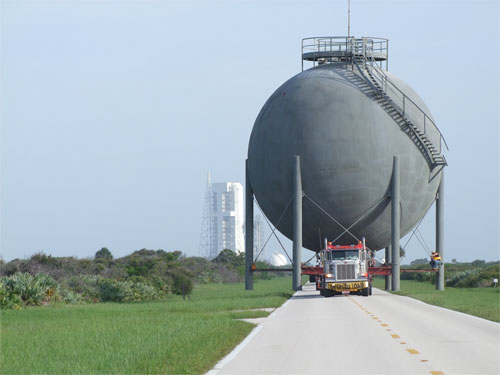 Above: Extra Wide Load - A flatbed truck delivers a 125,000 gallon Liquid Oxygen Tank to the new SpaceX launch complex at SLC-40, Cape Canaveral, Florida. The tank will support fueling of the new Falcon 9 rocket, scheduled for first delivery by the end of 2008. Credit: SpaceX "Our developments at Complex 40 continue with great speed," added Brian Mosdell, Director of Florida Launch Operations for SpaceX. "We have moved our massive oxygen storage tank into place, and expect to complete construction of our hangar later this year." Mosdell cited other supporters instrumental to SpaceX's efforts including the members of the Florida congressional delegation, the USAF Space Command, Col. Scott Henderson, Commander, 45th Launch Group, Col. (ret.) Mark Bontrager, formerly Commander of the 45th Mission Support Group, the public-private partnership Space Florida, and the Space Coast Economic Development Commission. In operation since 1965, and located south of NASA's launch sites for the Apollo moon missions and Space Shuttle flights, SLC-40 has hosted numerous historic launches, including the departure of two interplanetary missions: the Mars Observer satellite, and the Cassini spacecraft now exploring the rings and moons of the planet Saturn. 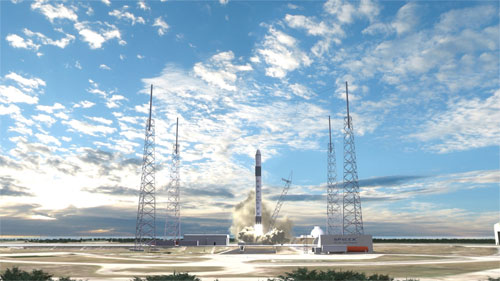 Computer simulation of SpaceX's Falcon 9 and Dragon spacecraft lifting off from Space Launch Complex 40 (SLC-40) at Cape Canaveral, FL. Credit: NASA About SpaceX SpaceX is developing a family of launch vehicles, Falcon 1, Falcon 9 and Falcon 9 Heavy, to increase the reliability and cost effectiveness of both manned and unmanned space transportation, ultimately by a factor of ten. Falcon 9 is a two-stage, liquid oxygen and rocket grade kerosene powered launch vehicle, offering breakthrough reliability derived from the nine-engine, single tank first stage configuration. Falcon 9 is the first American launch vehicle since the Saturn V to offer true engine out redundancy and reliability. Falcon 9 can deliver up to 12,500 kg to low Earth orbit (LEO) and 4,640 kg to Geostationary Transfer Orbit (GTO), while the Falcon 9 Heavy can loft 29,610 kg to LEO and 15,010 kg to GTO. Both rockets will operate from SLC-40, and payloads to Earth and Geostationary orbits and beyond will include commercial satellites, cargo and crew supply missions to the International Space Station (ISS), and future orbiting destinations. As a winner of the NASA Commercial Orbital Transportation Services competition (COTS), SpaceX is in a position to help fill the gap in U.S. spaceflight to the International Space Station (ISS) when the Space Shuttle retires in 2010. Under the existing Agreement, SpaceX will conduct three flights of its Falcon 9 launch vehicle and Dragon spacecraft for NASA, culminating in Dragon berthing with the ISS. As the only COTS contender with the capability to return cargo and crew to Earth, NASA also has an option for SpaceX to demonstrate crew transport services to the ISS. Founded in 2002, the SpaceX team now numbers more than 500, located primarily in Hawthorne, California, with four additional locations: SpaceX's Texas Test Facility in McGregor near Waco; offices in Washington DC; and launch facilities at Cape Canaveral, Florida; and the Marshall Islands in the Central Pacific. The SpaceX manifest currently lists 11 missions, plus indefinite delivery / indefinite quantity (IDIQ) contracts with NASA and the US Air Force. |
Robert Pearlman
Editor Posts: 42988
From: Houston, TX
Registered: Nov 1999
|
 posted 09-20-2008 09:41 AM
posted 09-20-2008 09:41 AM
   
Update from SpaceX CEO Elon Musk As mentioned in my update last month, we do expect to conduct a launch countdown in late September — as scheduled.Having said that, it is still possible that we encounter an issue that needs to be investigated, which would delay launch until the next available window in late October. If preparations go smoothly, we will conduct a static fire on Saturday and launch sometime between Tuesday and Thursday (California time). The SpaceX team worked hard to make this launch window, but we also took the time to review data from Flight 3 in detail. In addition to us reviewing the data, we had several outside experts check the data and conclusions. No flight critical problems were found apart from the thrust transient issue. Flight 5 production is well underway with an expected January completion date, Flight 6 parts are on order and Flight 7 production will begin early next year. We are now in steady state production of Falcon 1 at a rate of one vehicle every four months, which we will probably step up to one vehicle every two to three months in 2010. 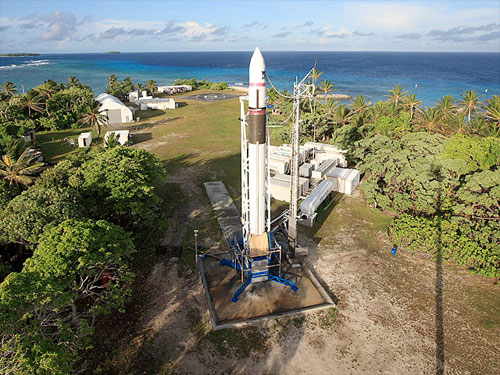 Above: SpaceX's Falcon 1 Flight 4 on the launch pad at Omelek Island in the Kwajalein Atoll of the Marshall Islands (Sept. 19, 2008). |
SpaceAholic
Member Posts: 4437
From: Sierra Vista, Arizona
Registered: Nov 1999
|
 posted 09-20-2008 10:11 AM
posted 09-20-2008 10:11 AM
   
Strange seeing a launch facility in such close proximity to so much (combustible) foliage... |
Robert Pearlman
Editor Posts: 42988
From: Houston, TX
Registered: Nov 1999
|
 posted 09-23-2008 03:44 PM
posted 09-23-2008 03:44 PM
   
SpaceX release Flight 4 of Falcon 1 | Static FireThe static fire took place on Saturday [20 Sep 2008, CA time], as expected, and no major issues came up. However, after a detailed analysis of data, we decided to replace a component in the 2nd stage engine LOX supply line. There is a good chance we would be ok flying as is, but we are being extremely cautious. This adds a few extra days to the schedule, so the updated launch window estimate is now Sept 28th through Oct 1st [CA time]. 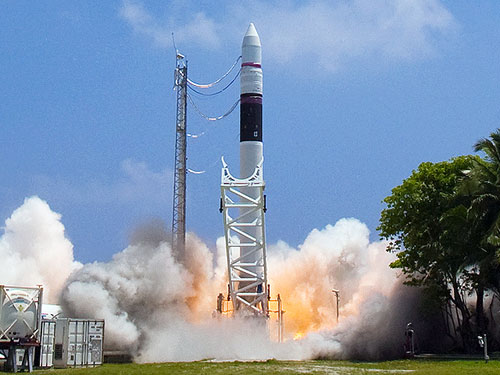 |
Robert Pearlman
Editor Posts: 42988
From: Houston, TX
Registered: Nov 1999
|
 posted 09-27-2008 07:40 PM
posted 09-27-2008 07:40 PM
   
SpaceX release Flight 4 of Falcon 1Falcon 1 is currently cleared for liftoff sometime between 4 p.m. and 9 p.m. (California time) tomorrow, Sunday September 28th. Of course, if we see anything that requires investigation, the launch will be postponed, but we'll let you know as soon as we know. As with prior flights, you can access the webcast from the SpaceX site. |
Robert Pearlman
Editor Posts: 42988
From: Houston, TX
Registered: Nov 1999
|
 posted 09-28-2008 06:29 PM
posted 09-28-2008 06:29 PM
   
Successful launch! "That was freakin' awesome." — Elon Musk, SpaceX CEO 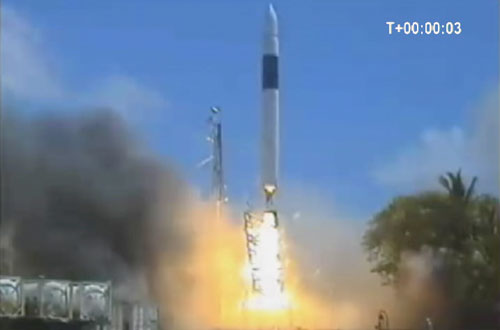 September 28, 2008 - 16:26 PDTT+0:08:21 Falcon 1 reached orbital velocity, 5200 m/s Nominal Second stage cut off (SECO) - Falcon 1 has made history as the first privately developed liquid fueled launch vehicle to achieve earth orbit!!!!!! The Falcon 1 Flight 4 vehicle carried a payload mass simulator of approximately 165 kg (364 lbs), designed and built by SpaceX specifically for this mission. - SpaceX Successfully Launches Falcon 1 Rocket Into Orbit - Space.com
Musk said his team nicknamed the mock satellite "RatSat" -- it's emblazoned with a rat logo — and it should stay in orbit between five and 10 years. - Private Company Launches Its Rocket Into Orbit — The New York Times
In a news conference after the launching, Mr. Musk told reporters, "It's great to have this giant monkey off my back." - Valley billionaire launches rocket into orbit - San Jose Mercury News
"Falcon 1 has made history as the first privately developed launch vehicle to reach Earth orbit from the ground!" launch commentator Max Vozoff exclaimed as the Falcon 1's second-stage engine cut-off, its onboard camera showing a stunning view of the blue Earth more than 100 miles below.
|
Robert Pearlman
Editor Posts: 42988
From: Houston, TX
Registered: Nov 1999
|
 posted 09-29-2008 01:44 AM
posted 09-29-2008 01:44 AM
   
SpaceX release SpaceX Successfully Launches Falcon 1 to OrbitSpace Exploration Technologies Corp. (SpaceX) announces that Flight 4 of the Falcon 1 launch vehicle has successfully launched and achieved Earth orbit. With this key milestone, the Falcon 1 becomes the first privately developed liquid fuel rocket to orbit the Earth. 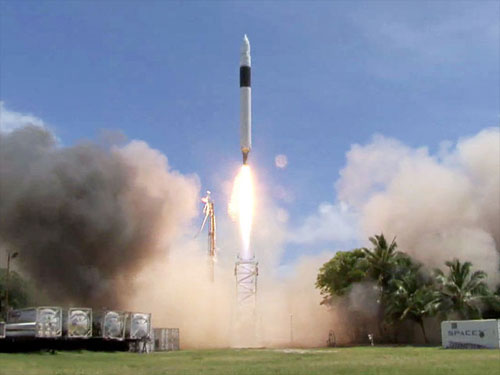 "This is a great day for SpaceX and the culmination of an enormous amount of work by a great team," said Elon Musk, CEO and CTO of SpaceX. "The data shows we achieved a super precise orbit insertion -- middle of the bulls-eye -- and then went on to coast and restart the second stage, which was icing on the cake." Falcon 1, designed from the ground up by SpaceX, lifted off at 4:15 p.m. (PDT) / 23:15 (UTC) from the Reagan Test Site (RTS) on Omelek Island at the U.S. Army Kwajalein Atoll (USAKA) in the Central Pacific, about 2,500 miles southwest of Hawaii. Preliminary data indicates that Falcon 1 achieved an elliptical orbit of 620 km by 660 km, 9 degrees inclination. Falcon 1 carried into orbit a payload mass simulator of approximately 165 kg (364 lbs), designed and built by SpaceX, specifically for this mission. Consisting of a hexagonal aluminum alloy chamber 1.5 meters (5 feet) tall, the payload attached to the standard Falcon 1 payload mounting structure and remains attached to the second stage as it orbits Earth. This was the fourth launch of the Falcon 1 launch vehicle and second flight for the new SpaceX-developed Merlin 1C regeneratively-cooled engine. A "hold before liftoff" system was used to enhance reliability by permitting all launch systems to be verified as functioning nominally before launch was initiated. A single SpaceX-developed Kestrel engine powered the Falcon 1 second stage. For more information about the Falcon family of vehicles, and to watch the archived video of the Falcon 1, Flight 4 launch, visit the SpaceX website. |
Robert Pearlman
Editor Posts: 42988
From: Houston, TX
Registered: Nov 1999
|
 posted 10-08-2008 01:35 PM
posted 10-08-2008 01:35 PM
   
SpaceX update from Elon Musk: Flight 4 Launch UpdateA week spent reviewing data has confirmed that the flight went really well, including the coast and restart. The mood here at SpaceX is just ecstatic! This is the culmination of six years of hard work by a very talented team. It is also a great relief for me, who led the overall design of the rocket (not a role I expected to have when starting the company). I felt a little sheepish receiving the AIAA award for the most outstanding contribution to the field of space transportation two weeks before this flight. Orbit was achieved with the first burn terminating at 330.5 km altitude and 8.99 degree inclination. The goal for initial insertion was a 330 km altitude and a 9.0 degree inclination, so this was right on target! Accuracy far exceeded our expectations, particularly given that this was the first time Falcon 1 reached orbit. The primary purpose of the second burn was to test the restart capability and then burn as long as possible. The upper stage coasted for 43.5 minutes and then burned for 6.8 seconds, which is 4 seconds longer than needed to circularize. Most of the burn was actually done sideways to avoid creating a highly elliptical orbit, hence a change in inclination to 9.3 degrees. The final orbit, confirmed by US Space Command, was 621 km by 643 km. As an added bonus, we picked up several minutes of video and data from the upper stage when it passed over Kwajalein one orbit later, which showed the stage to be in good condition. You can see some eerie footage of the upper stage drifting in zero g at the end of this video clip. While Falcon 1 was the world's first privately developed liquid fuel rocket to reach orbit, I would like to acknowledge and express appreciation for the role of DARPA, the Air Force and the ORS Office of the Department of Defense. They played an important role as early 'beta' customers of Falcon 1. There are many individuals in those organizations, as well as in NASA, NRL, FAA, USAKA/RTS, other departments of the US government and the private sector to whom we owe gratitude for their support and advice. You didn't have to help, but you did, often at risk of career and credibility, so you have my deepest thanks. The next flight of Falcon 1 is tentatively scheduled for March next year and will carry a Malaysian primary satellite, as well as US government secondary satellites, to near equatorial orbit. Flight 6 will probably be a Defense Department satellite in the summer and Flight 7 a commercial satellite mission in the fall. In 2010, I expect the launch cadence for Falcon 1 to step up to a mission every two to three months. Here is a highlight reel of the Falcon 1 flight, including the restart and video footage from the upper stage when it does its first orbit back over Kwajalein. Some of this has not been show before, so there is something new even if you watched the live webcast. |
Robert Pearlman
Editor Posts: 42988
From: Houston, TX
Registered: Nov 1999
|
 posted 12-10-2008 09:32 AM
posted 12-10-2008 09:32 AM
   
SpaceX release SpaceX Draco Thruster Performs Long-Duration Firing and RestartJust days after the successful full mission-length test firing of the nine-engine first stage of Falcon 9, Space Exploration Technologies Corp. (SpaceX) marked another significant advance with the performance of its smallest rocket engine, Draco. Known as a "thruster," the new engine fired continuously for ten minutes in a specially constructed vacuum test chamber that simulates the space environment. After a ten-minute thermal soak period, Draco was restarted for an additional minute, simulating its typical use in space. 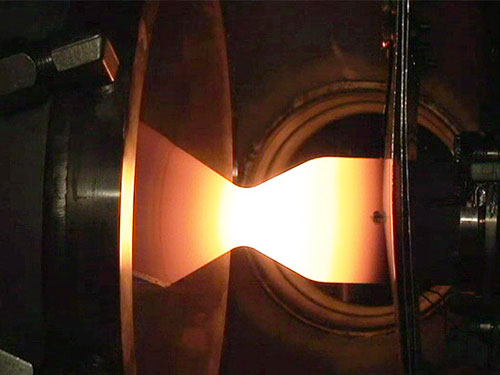 Performed at the SpaceX Texas Test Facility outside McGregor, this marks the longest firing of the Draco thruster, as well as the longest test on the new vacuum test stand, built by SpaceX and first put into operation in March 2008. "Draco performed perfectly during the entire test, with expected temperatures and excellent performance," said David Giger, Propulsion Manager, SpaceX. "We also broke the SpaceX record for longest continuous burn previously held by Kestrel, the Falcon 1 second stage engine." SpaceX's Dragon spacecraft uses a total of 18 Draco thrusters for maneuvering, attitude control, and to initiate the capsule's return to Earth. "The Draco engines are as important to Dragon as the large Merlin engines are to Falcon 9," said Tom Mueller, VP Propulsion, SpaceX. "They will perform essential maneuvers as the SpaceX Dragon approaches and berths with the International Space Station (ISS) to provide delivery of cargo, and eventually crew transport to and from Station." The SpaceX-developed Draco thruster generates up to 90 pounds (400 Newtons) of force using monomethyl hydrazine as a fuel and nitrogen tetroxide as an oxidizer - the same orbital maneuvering propellants used by the Space Shuttle. These storable propellants have very long on-orbit lifetimes, providing the option for the Dragon spacecraft to remain berthed at the ISS for a year or more, ready to serve as an emergency "lifeboat" if necessary. The first Dragon spacecraft is scheduled for flight in 2009 aboard a Falcon 9 rocket from the SpaceX launch site at Complex 40, Cape Canaveral, Florida. |
Robert Pearlman
Editor Posts: 42988
From: Houston, TX
Registered: Nov 1999
|
 posted 03-18-2009 07:04 PM
posted 03-18-2009 07:04 PM
   
SpaceX update Preparations for Flight 5 of Falcon 1 are well underway at SpaceX. Flight 5 will loft an Earth observation satellite called RazakSAT into orbit for the Government of Malaysia, plus two secondary payloads that will deploy separately.SpaceX's Falcon 1 launch site lies approximately 5,000 miles away from Los Angeles, on Omelek Island, which is part of the United States Army Kwajalein Atoll. Omelek is nearly 2,500 miles southwest of Hawaii, and just 9.1 degrees north latitude, making it a great location for launching rockets. Currently, Flight 5 is scheduled for an April 21st launch which corresponds with April 20th in the US. Having passed final factory checkouts, we recently transferred the completed Falcon 1 first stage to a shipping structure, and wrapped it securely for travel (see photos). Departing from our Hawthorne headquarters via flatbed truck, the first stage traveled south to the Long Beach harbor, where we loaded it on to a large oceangoing transport for a voyage across the Pacific. In the coming weeks, the Falcon 1 second stage will depart from California and travel by aircraft to Kwajalein, then by boat the short distance to Omelek. As the components arrive in close succession at the launch site, our Launch Operations crew will conduct the final integration, testing and preparations for flight. Watch for further Flight 5 updates as progress continues. 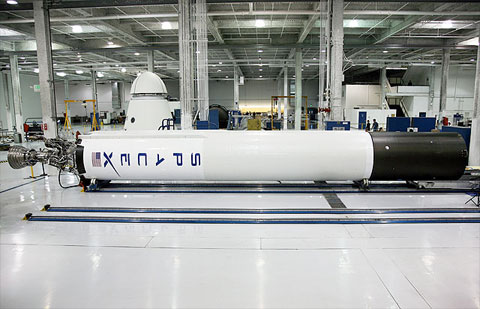 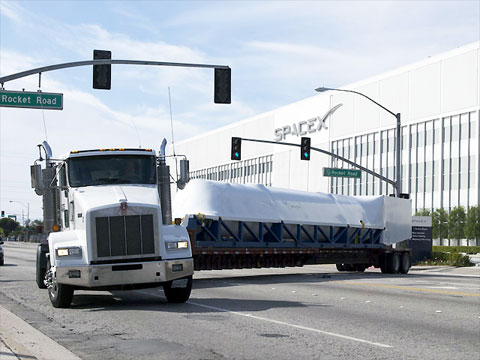
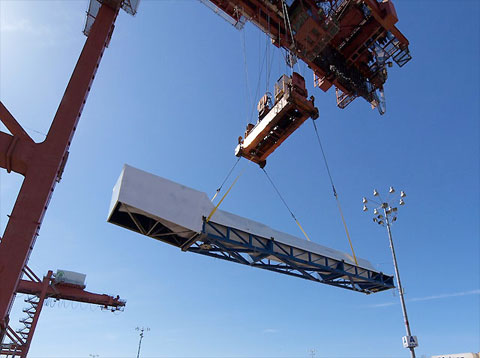
|
Robert Pearlman
Editor Posts: 42988
From: Houston, TX
Registered: Nov 1999
|
 posted 03-30-2009 12:56 PM
posted 03-30-2009 12:56 PM
   
SpaceX release SpaceX to Launch ATSB's RazakSATSpace Exploration Technologies (SpaceX) announces that the launch window for ATSB's RazakSAT on Falcon 1 Flight 5, is currently scheduled to open Monday, April 20th at 4:00 p.m. (PDT) / 7:00 p.m. (EDT).
SpaceX's Falcon 1 launch site is located approximately 2500 miles southwest of Hawaii on Omelek Island, part of the Reagan Test Site (RTS) at United States Army Kwajalein Atoll (USAKA) in the Central Pacific. Due to the location of the launch site, the Kwajalein local date at the opening of the launch window will be April 21st.
RazakSAT was designed and built by Astronautic Technology (M) Sdn Bhd (ATSB), a pioneer and leader in the design and manufacture of satellites in Malaysia. The satellite will be launched aboard the Falcon 1, a two-stage, liquid oxygen/rocket-grade kerosene vehicle, designed from the ground up by SpaceX.
Falcon 1 will place RazakSAT, equipped with a high resolution Medium-Sized Aperture Camera (MAC), into a near equatorial orbit. The payload is expected to provide high resolution images of Malaysia that can be applied to land management, resource development and conservation, forestry and fish migration.
SpaceX will provide live coverage of the Falcon 1 Flight 5/RazakSAT mission via webcast at: SpaceX.com. The webcast will begin 20 minutes prior to launch and will include mission briefings, live feeds and launch coverage from the launch site. Post-launch, video footage and photos will be available for download on the website. |
Robert Pearlman
Editor Posts: 42988
From: Houston, TX
Registered: Nov 1999
|
 posted 07-14-2009 01:22 AM
posted 07-14-2009 01:22 AM
   
SpaceX release SpaceX's Falcon 1 Successfully Delivers RazakSAT Satellite To OrbitSpace Exploration Technologies (SpaceX) announces the successful launch of Falcon 1 and delivery of Malaysia's RazakSAT into the correct orbit. "This marks another successful launch by the SpaceX team," said Elon Musk, CEO and CTO of SpaceX. "We are pleased to announce that Malaysia's RazakSAT, aboard Falcon 1, has achieved the intended orbit." Falcon 1, a two-stage, liquid oxygen/rocket-grade kerosene vehicle designed and manufactured by SpaceX, lifted off Monday, July 13, at 8:35 pm (PDT). Lift off occurred from the Reagan Test Site (RTS) on Omelek Island at the U.S. Army Kwajalein Atoll (USAKA) in the Pacific Ocean, approximately 2,500 miles southwest of Hawaii. RazakSAT was designed and built by Astronautic Technology (M) Sdn Bhd (ATSB), a pioneer and leader in the design and manufacture of satellites in Malaysia. "Our ground systems were able to pick up communication from RazakSAT on its first pass," said Norhizam Hamzah, Senior Vice President / Chief Technical Officer, Space Systems Division, ATSB. "The satellite is communicating as expected and our team will continue to monitor the data closely." Preliminary data indicates that the RazakSAT, equipped with a high resolution Medium-Sized Aperture Camera (MAC), achieved the intended Near-Equatorial Low Earth Orbit (NEqO) at 685 km altitude and a 9 degree inclination. The payload is expected to provide high resolution images of Malaysia that can be applied to land management, resource development and conservation, forestry and fish migration. For more information about the Falcon family of vehicles, and to watch the Falcon 1 Flight 5 video, visit the SpaceX website. | |
Contact Us | The Source for Space History & Artifacts
Copyright 2020 collectSPACE.com All rights reserved.

Ultimate Bulletin Board 5.47a
|
|

|
 advertisement advertisement

|


























